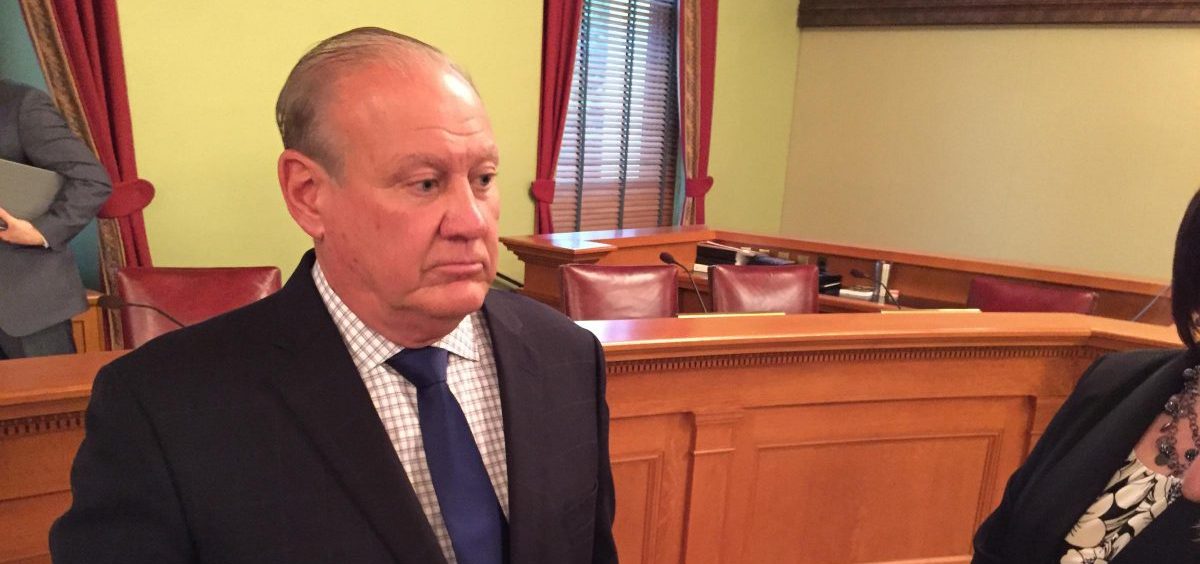News

FirstEnergy Corp, FirstEnergy Solutions: What’s The Difference?
By: Andy Chow | Statehouse News Bureau
Posted on:
The Ohio House is considering a piece of legislation, HB6, that will create a new fee on electric bills and scrap the state’s green energy standards. FirstEnergy Solutions’ two nuclear plants would stand to greatly benefit from the bill through large subsidies. There’s a long history between FirstEnergy Solutions and its former parent company FirstEnergy Corp, a large GOP donor.
FirstEnergy Corp and FirstEnergy Solutions are not the same company.
That’s the one thing Chuck Jones, FirstEnergy Corp’s CEO, wanted to make very clear to Ohio lawmakers in a letter he sent in February.
They might share the same name, but they’re not operated by the same people. They are independent of each other.
And FirstEnergy Solutions may have been a subsidiary of FirstEnergy Corp, up until last year, but they are not the same company anymore.
FirstEnergy Corp is an energy distribution company, which delivers power to homes in northeast Ohio, and charges for that transmission through a monthly electric bill.
FirstEnergy Solutions is an energy generation company, which runs power plants including coal and nuclear.
Jones wrote the letter about two months before House Republicans rolled out a plan that could help save FirstEnergy Solutions’ two nuclear plants, Davis-Besse and Perry.
That plan would overhaul the state’s green energy policy, and grant nuclear power about $170 million through so-called “clean air” credits.”
FirstEnergy Corp has been a major political contributor. Last year the company donated more than $150,000 to House Republican campaigns. But Jones’ letter stresses that any bill to subsidize energy plants would not financially benefit his company.
However, that wasn’t always the case.
An effort to subsidize the Davis-Besse and Perry nuclear power plants has been going on for years now. And FirstEnergy Corp had been a vocal advocate, if not the driving force behind that effort.
Even Jones himself visited the Statehouse to testify in support of a bill to grant zero carbon emission credits to the nuclear plants in May 2017, before the two companies completely separated.
That plan would’ve charged residential customers about $5 a month. Jones listed off the reasons why the power plants were worth the proposed subsidies.
“They need to decide, do the attributes of these plants are they worth $5 a month to the average customer. The zero carbon attributes, the grid security attributes, the fuel security attributes the 24-7 round the clock service attributes,” Jones says.
This was before FirstEnergy Solutions filed for bankruptcy last March and before FirstEnergy Solutions completely separated from Jones’ FirstEnergy Corp last year. But even then, Jones foreshadowed his position on a bill that would save the plants.
“Even if that happens, and there’s no future for these plants to be part of FirstEnergy, I will continue to fight for this legislation because it’s still the right thing to do,” says Jones.
There were many twists and turns in the long journey that ultimately resulted in the split between FirstEnergy Corp and FirstEnergy Solutions.
You could go all the way back to 1999 when Ohio lawmakers approved the switch to a deregulated electricity market.
A regulated utilities industry means you’d be paying for electricity at more of a fixed rate, where a deregulated system that promotes competition among a lot of energy generators would bring electricity at its lowest cost.
The Public Utilities Commission of Ohio created a process to slowly implement deregulation. FirstEnergy was onboard for the switch back in 2008, and it appeared the utility company would stand to benefit since it was operating low-cost coal plants.
But then the shale boom hit Ohio and natural gas was coming online at a large, inexpensive rate. Then there was the development of renewable energy, the increase of energy efficiency programs, and independent energy retailers, all of which created a more competitive energy market.
By 2015, FirstEnergy switched its position and wanted Ohio to go back to a re-regulated market. That’s when they started seeking legislative and regulatory help for their now struggling plants.
Critics accuse FirstEnergy Corp of using the bankruptcy case as a way to avoid its financial and environmental responsibility.
FirstEnergy Solutions, says it plans to shut down the Davis-Besse and Perry nuclear plants if they can’t get legislative relief.
The bill in the Ohio House would charge every residential ratepayer an extra $2.50 on their monthly electric bill, but do away with the green energy standards which bring other costs to that monthly bill. Getting rid of the renewable and efficiency standards was another goal of FirstEnergy Corp.
The names of the companies can lead to confusion. And it may be a while before that will be resolved. FirstEnergy Solutions plants to rebrand itself, including a new company name, after its bankruptcy case which is pending in federal court.


